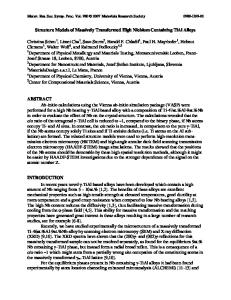Effect of niobium on the oxidation behavior of TiAl
- PDF / 259,844 Bytes
- 5 Pages / 585 x 783 pts Page_size
- 66 Downloads / 382 Views
YanJun Xi Department of Materials and Chemical Engineering, Zhongyuan Institute of Technology
FuHui Wang State Key Laboratory for Corrosion and Protection, Institute of Metal Research, Chinese Academy of Sciences, Shenyang 110016, P.R. China (Received 16 September 2006; accepted 16 November 2006)
Two TiO2 layers formed in TiAl oxidation for 50 h at 900 °C were studied using scanning transmission electron microscopy. The main efforts were placed on the investigation of the distribution of niobium. It was found that Nb enriched in TiO2 grains of mixture layer but did not exist in the outer TiO2 layer. High-resolution electron microscopy (HREM) Z-contrast image revealed that Nb substitute for Ti site leading to Nb enrichment in TiO2 grains of the mixture layer. The formation mechanism of the two TiO2 layers and the potential effect of Nb doping in the mixture layer were also discussed.
1. INTRODUCTION
TiAl-based alloys that constitute important intermetallic systems have been the subject of numerous studies in recent years, owing to their potential for hightemperature structure applications. However, their applications are limited by their relatively poor oxidation performance.1 A better understanding of the oxidation mechanisms is important for further progress in the alloy development.2–4 According to previous work,3,5–8 the fundamental aspects of the oxidation behaviors, such as oxidation kinetics and scale morphology of binary TiAl, have been investigated extensively. The investigations reveal that oxidation of TiAl generally leads to a complex scale with a layered structure. The outer layer is mainly composed of TiO2 after some hours of oxidation. Becker et al. reported that the inner layers were composed of a TiO2 + Al2O3 mixture layer and an Al-depleted zone.3 Schemet et al. observed an alumina layer between the out layer and TiO2 + Al2O3 mixture layer. Besides, they also found that the layer beneath the mixture layer was mainly composed of TiN and Ti2AlN.6 In the TiO2 + Al2O3 mixture layer, pores are always enriched.7,9 Some investigations3,10 concerned the effect on oxidation behavior of adding an alloy element. It is shown that a suitable cona)
Address all correspondence to this author. e-mail: [email protected] DOI: 10.1557/JMR.2007.0188 1486
J. Mater. Res., Vol. 22, No. 6, Jun 2007
tent of Nb addition can improve the oxidation resistance of TiAl alloy. However, the existence status and the effect of Nb in the mixture layer are unclear. In this work, the distribution and the effect of Nb in the oxidation of TiAl alloy are investigated. Combined with defect chemistry and experimental results, the mechanism of Nb enriching in TiO2 grains in the mixture layer but not existing in the outer TiO2 layer is discussed. 2. EXPERIMENTAL
The TiAl alloy used for this study has a full lamella structure with the nominal composition of Ti–46.5Al– 5Nb (at.%). To perform isothermal oxidation, the specimens were cut into a size of 15 × 10 × 2.5 mm3 from the ingots. The surface of the specimens was polished to 800 SiC paper
Data Loading...











